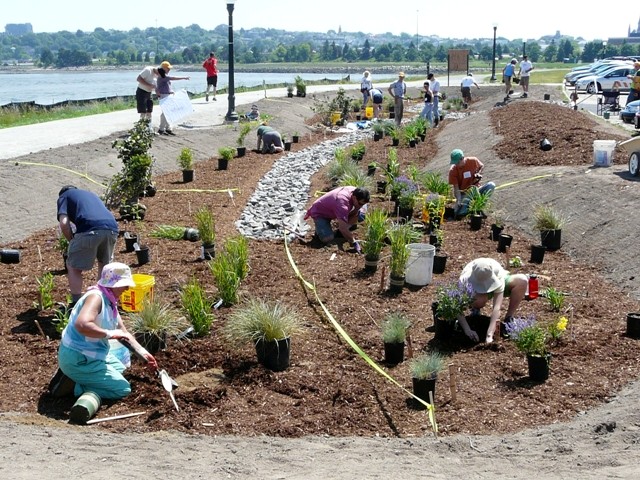The city of Portland has a new rain garden that is filtering water from about a quarter of the Back Cove parking lot on Preble Street extension.
And this is a serious rain garden.
Designed and paid for by Stantec, a national engineering firm with a Portland office, it has specially engineered soil, 168 carefully selected plants, berms to keep the water in the garden while it drains and a complex system of pipes.
The price tag is going to be $65,000 to $75,000, according to Pat Clark, the head Stantec engineer for the project, and it will be paid for with research and development grants through Stantec.
One interesting thing, Clark said, is that you can build a smaller version of the rain garden for your own home.
Doug Roncarati of the city’s department of public services said the rain garden is another part of Portland’s efforts to reduce the amount of pollution going into Casco Bay, and Back Cove in particular.
The city has been working for years to separate storm and sanitary sewers, and the rain garden will play a role in that by filtering out spilled oil, fertilizers, pesticides and other pollution that comes from the surrounding yards.
The public has shown an interest in the project — especially the volunteers who spent a Saturday two weekends ago planting the garden along with city workers.
“A lot of people stopped by and asked questions about it and what it will do,” Roncarati said. “Many of them were pleased that Portland was taking such a forward-looking step to help take care of the water quality.”
Tom Emery, a landscape architect with Stantec, stressed that the rain garden won’t be fully operational until the plants have grown for a couple of years.
I asked him if the plants used in the garden were bog plants.
“People would generally think that,” Emery said. “There is only going to be a 6-inch depth of water there at any time, and it will be there not more than 24 hours. The engineered filter medium there is what I would think of as sandy loam that will filter well, and not clays that would coagulate a bit.”
That means when it has not rained recently, the soil will be dry. Emery said the plants were watered well when they went in, but they suffered a bit after the sun came out, when temperatures rose and the wind came up. Until the plants get established, there will be some irrigation.
Emery sent me a list of plants, and the ones they chose are all tough and mostly native. Two red oaks are the only trees. Six sweetfern and six viburnum carlesii are the only shrubs.
The other 150 plants include anemones, asters, columbine, baptisia, crested and Siberian irises, repeat-blooming day lilies, bee balm, black-eyed Susans and grasses including panicums, fescues, an oat and Little Bluestem.
Clark, the Stantec engineer, explained the system.
He said the state’s Department of Environmental Protection requires the garden to capture one inch of rainfall over the entire area of pavement in the quarter of the parking lot it will serve.
“The rain garden sits mostly below the surface, so you don’t really see it,” he said. “When it is fully filled, all you will see is a 6-inch puddle with plants in it.”
The top layer of the system is 14 inches of engineered soil, where the plants are placed. That soil will also do some filtering.
The second layer is an 18-inch sand filter with perforated pipes that will take the water to the catch basin that served the section of parking lot before the rain garden was installed. The grate for the catch basin has now been covered.
Clark said the rain garden is a bio-retention cell, and that the plants in the garden will take up some of the water — and also use up some of the pollutants in the water.
Some of the water will filter down into the ground and eventually the aquifers beneath the ground. Some will evaporate. And the rest will go into Back Cove.
Clark said the technology is about 20 years old, but it hasn’t been done often in cooler climates, and the research part of the garden is to see how the rain garden works in Maine. The water going out into Back Cove will be tested to see how clean it is.
As a person who spends too much time cleaning filters in hoses, vacuum cleaners, pump sprayers and the like, I asked Clark how long it would take for the filter mediums to get clogged.
He said he didn’t know, but expected 25 years or more — although he has seen some get clogged more quickly.
Clark also said more home and garden centers are carrying the engineered soil used in the rain garden, so you could make a similar rain garden at home.
But he also said that in a home environment, just a dip in your yard with plants works pretty well to prevent runoff from your roof and driveway.
Tom Atwell can be contacted at 791-6362 or at
tatwell@pressherald.com.
Send questions/comments to the editors.


